Remove the cam follower (A) and hydraulic lash adjuster (HLA) (B).
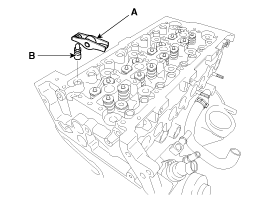
Remove the engine and transaxle assembly.
(Refer to Engine And Transaxle Assembly - "Engine And Transaxle Assembly")
Remove the intake manifold.
(Refer to Intake And Exhaust System - "Intake Manifold")
Remove the EGR & thermostat housing assembly.
(Refer to Cooling System - "Water Temperature Control Assembly")
Remove the exhaust manifold.
(Refer to Intake And Exhaust System - "Exhaust Manifold")
Remove the lower oil pan and upper oil pan.
(Refer to Lubrication System - "Oil Pan")
Remove the timing chain "B".
(Refer to Timing System - "Timing Chain")
Remove the common rail.
(Refer to Engine Control/Fuel System - "Common Rail")
Remove the glow plug and the wiring & plate.
(Refer to Engine Electrical System - "Glow Plug")
Remove the vacuum pump.
(Refer to Cylinder Head Assembly - "Vacuum Pump")
Remove the camshaft and cam carrier.
(Refer to Cylinder Head Assembly - "Camshaft")
Remove the cam follower (A) and hydraulic lash adjuster (HLA) (B).

Remove the cylinder head.
Remove the cylinder head side bolt (A).
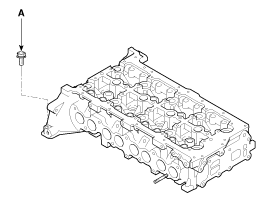
Using bit socket (12PT), uniformly loosen and remove the 10 cylinder head bolts, in several passes, in the sequence shown.
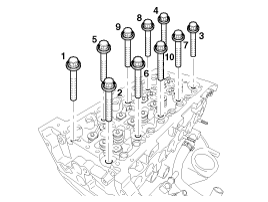
Head warpage or cracking could result from removing bolts in an incorrect order.
Lift the cylinder head (A) from the dowels on the cylinder block and put the cylinder head on wooden blocks on a bench.
Be careful not to damage the contact surfaces of the cylinder head and cylinder block.
Remove the cylinder head gasket (B).
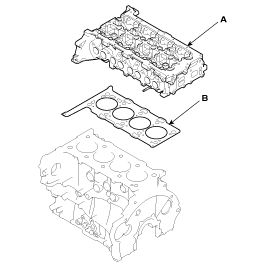
Using the SST (09222-3K000, 09222-2A100) (A), compress the valve spring and remove the retainer lock (B).
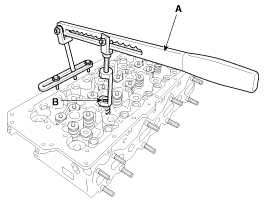
Remove the spring retainer (C).
Remove the valve spring (D).
Remove the valve (E).
Using a needle-nose pliers, remove the stem seal (F).
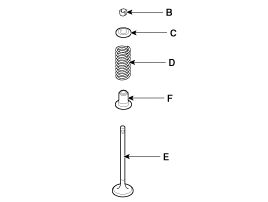
Inspect for flatness.
Using a precision straight edge and feeler gauge, measure the surface the contacting the cylinder block and the manifolds for warpage.
Flatness of cylinder head gasket surface :
Less than 0.03 mm (0.0012 in) for width
Less than 0.09 mm (0.0035 in) for lengthh
Less than 0.012 mm (0.0005 in) for a section of 50 mm x 50 mm (1.9685 in x 1.9685 in)
Flatness of manifold mating surface :
Less than 0.025 mm (0.0010 in) for width
Less than 0.160 mm (0.0063 in) for length
Less than 0.013 mm (0.0005 in) for a section of 25 mm x 25 mm (0.9843 in x 0.9843 in)
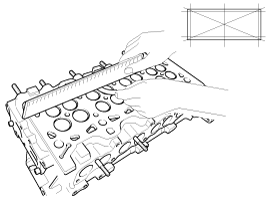
Inspect for cracks.
Check the combustion chamber, intake ports, exhaust ports and cylinder block surface for cracks.
If cracked, replace the cylinder head.
Inspect the valve stems and valve guides.
Using a caliper gauge, measure the inner diameter of valve guide.
Valve guide inner diameter :
5.975 ~6.000 mm (0.2352 ~ 0.2362 in)
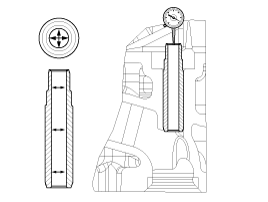
Using a micrometer, measure the outer diameter of valve stem.
Valve stem outer diameter
Intake : 5.933 ~ 5.953 mm (0.2336 ~ 0.2344 in)
Exhaust : 5.905 ~ 5.925 mm (0.2325 ~ 0.2333 in)
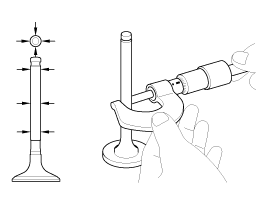
Subtract the valve stem outer diameter measurement from the valve guide inner diameter measurement.
Valve stem- to-guide clearance
Intake : 0.022 ~ 0.067 mm (0.0009 ~ 0.0026 in)
Exhaust : 0.050 ~ 0.095 mm (0.0020 ~ 0.0037 in)
If the clearance is greater than specification, replace the valve or the cylinder head.
Inspect the valves.
Check the valve is ground to the correct valve face angle.
Check that the surface of valve for wear.
If the valve face is worn, replace the valve.
Check the valve head margin thickness.
Margin
Intake : 1.25 mm (0.0492 in)
Exhaust : 1.25 mm (0.0492 in)
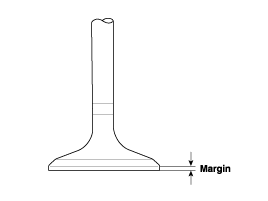
If the margin thickness is less than specification, replace the valve.
Check the valve length.
Length
Intake : 108.3 mm (4.2638 in)
Exhaust : 108.2 mm (4.2598 in)
Check the surface of valve stem tip for wear.
If the valve stem tip is worn, replace the valve.
Inspect the valve seats.
Check the valve seat for evidence of overheating and improper contact with the valve face.
If the valve seat is worn, replace the cylinder head.
Check the valve guide for wear.
If the valve guide is worn, replace the cylinder head.
Inspect the valve springs.
Using a steel square, measure the out-of-square of valve spring.
Using a vernier calipers, measure the free length of valve spring.
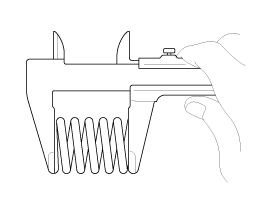
If the loads is not as specified, replace the valve spring.
Valve spring
Standard
Free height : 44.0 mm (1.7323 in)
Load : 19.9±1.0 kg (44±21 lb) / 36.6 mm (1.4409 in),
44.1±2.2 kg (97±5 lb) / 27.6 mm (1.0866 in)
Out of square : Less than 1.5° / 1.15 mm (0.0453 in)
With the HLA filled with engine oil, hold A and press B by hand.
If B moves, replace the HLA.
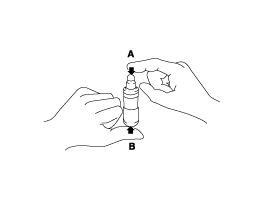
Problem | Possible cause | Action |
Temporary noise when starting a cold engine | Normal | This noise will disappear after the oil in the engine reaches the normal pressure. |
Continuous noise when the engine is started after parking more than 48 hours | Oil leakage of the high pressure chamber on the HLA, allowing air to get in | Noise will disappear within 15 minutes when engine runs at 2000-3000 rpm. If it doesn’t disappear, refer to the lowest step. note Do not run engine at a speed higher than 3000 rpm, as this may damage the HLA. |
Continuous noise when the engine is first started after rebuilding cylinder head | Insufficient oil in cylinder head oil gallery | |
Continuous noise when the engine is started after excessively cranking the engine by the starter motor or band | Oil leakage of the high-pressure chamber in the HLA, allowing air to get in and insufficient oil in the HLA | |
Continuous noise when the engine is running after changing the HLA | ||
Continuous noise during idle after high engine speed | Engine oil level too high or too low | Check oil level. Drain or add oil as necessary. |
Excessive amount of air in the oil at high engine speed | Check oil supply system. | |
Deteriorated oil | Check oil quality. If deteriorated, replace with specified type. | |
Noise continues for more than 15 minutes | Low oil pressure | Check oil pressure and oil supply system of each part of engine. |
Faulty HLA | Remove the cylinder head cover and press HLA down by hand. If it moves, replace the HLA. caution Be careful handling the hot HLA. |
Thoroughly clean all parts to be assembled.
Before installing the parts, apply fresh engine oil to all sliding and rotating surface.
Replace valve stem seals with new ones.
Using the SST (09222-1M100) (A), install a new stem seal (F).
Do not reuse old valve stem oil seals.
Incorrect installation of the seal could result in oil leakage past the valve guides.
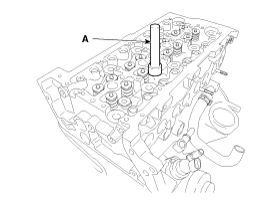
Install the valve (E), valve spring (D) and spring retainer (C).

Place the valve springs so that the side coated with enamel faces toward the valve spring retainer and then installs the retainer.
Using the SST(09222-3K000, 09222-2A100) (A), compress the spring and install the retainer locks (B).
Before releasing the valve spring compressor, ensure that the retainer locks are correctly in place after pushing down and releasing the compressor handle 2 ~ 3 times.

Thoroughly clean all parts to be assembled.
Always use a new cylinder head and manifold gasket.
Always use a new cylinder head bolt.
The cylinder head gasket is a metal gasket. Take care not to bend it.
Rotate the crankshaft, set the piston of No.1 cylinder at TDC (top dead center).
Clean the gasket mating surfaces of the cylinder head and block to remove oil, dust and scratches.
Select the cylinder head gasket.
Measure the piston protrusion from the upper cylinder block face on 8 places (A ~ H) at TDC.
Measure on the crankshaft center line considering the piston migration.
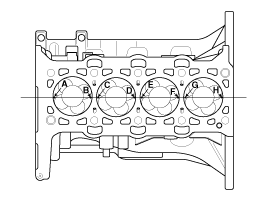
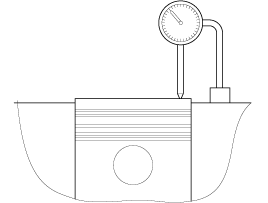
Select the gasket in the table below using the average value of piston protrusions.
Although even the only 1 point is over than the each rank limit, use 1 rank upper gasket than specified in the table below.
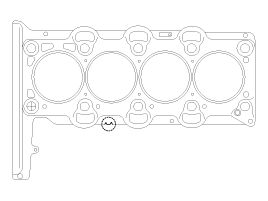
Displacement | 2.0L/2.2L | ||
Average of piston protrusion | 0.410 ~ 0.531 mm (0.0161 ~ 0.0209 in) | 0.531 ~ 0.602 mm (0.0209 ~ 0.0237 in) | 0.602 ~ 0.672 mm (0.0237 ~ 0.0265 in) |
Gasket thickness | 1.15 ~ 1.25 mm (0.0453 ~ 0.0492 in) | 1.25 ~ 1.35 mm (0.0492 ~ 0.0531 in) | 1.35 ~ 1.45 mm (0.0531 ~ 0.0571 in) |
Limit of each rank extant | 0.581 mm (0.0229 in) | 0.652 mm (0.0257 in) | 0.722 mm (0.0284 in) |
Identification code |  |  |  |
Install the cylinder head gasket (A) on the cylinder block.

Apply sealant on cylinder block top face before assembling cylinder head gaskets and apply sealant on cylinder head gaskets after assembling cylinder head gaskets on cylinder block.
Apply sealant (LOCTITE 5902 or equivalent) and assemble the cylinder head within 15 minutes.
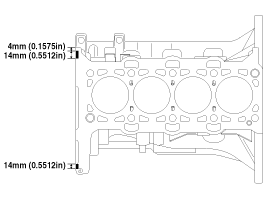
Seat the cylinder head gasket on the cylinder head firmly.
Be careful not to damage the bead and coating of the cylinder head gasket before and after assembling the cylinder head gasket.
Place the cylinder head (A) quietly in order not to damage the gasket with the bottom part of the end.
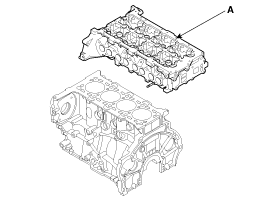
Install the cylinder head bolts.
Do not apply engine oil on the cylinder head bolts.
Using SST (09221-4A000), install and tighten the 10 cylinder head bolts, in several passes, in the sequence shown.
Tightening torque :
78.5 N.m (8.0 kgf.m, 57.9 lb-ft) + 120° + 120°
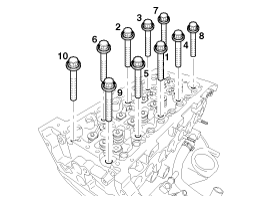
Do not reuse the cylinder head bolts.
Install the cylinder head side bolt (A).
Tightening torque :
30.4 ~ 34.3 N.m (3.1 ~ 3.5 kgf.m, 22.4 ~ 25.3 lb-ft)

Install the hydraulic lash adjuster (HLA) (B) and cam follower (A).

Until installing HLA shall be held upright so that engine oil in HLA should not spill and assured that dust does not adhere to HLA.
HLA should be inserted carefully to the cylinder head not to spill engine oil.
If engine oil has spilled out of the lash adjuster, HLA bleeding should be performed according to the below procedure.
HLA bleeding procedure
Stroke the lash adjuster in engine oil by pushing its cap 4 to 5 times while pushing the ball down slightly using a hard steel wire. Be careful not to give the ball a hard push because the ball weighs just several grams.
If installing with engine oil spilling out of the lash adjuster and air in it, it might make an abnormal noise.
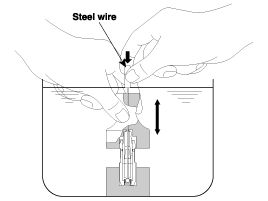
Install the other parts in the reverse order of removal.